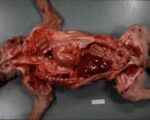Difference between revisions of "Diaphragmatic Rupture"
Jump to navigation
Jump to search
JamesSwann (talk | contribs) |
JamesSwann (talk | contribs) |
||
| Line 2: | Line 2: | ||
{|cellpadding="10" cellspacing="0" border="1" | {|cellpadding="10" cellspacing="0" border="1" | ||
| + | | Also known as: | ||
| + | |'''Acquired Diaphragmatic Hernia<br> | ||
| + | '''Displacement of Stomach into Thorax''' | ||
| Do not confuse with: | | Do not confuse with: | ||
|'''[[Hiatal Hernia]]<br> | |'''[[Hiatal Hernia]]<br> | ||
| − | '''[[Peritoneopericardial Hernia]]<br> | + | '''[[Hernia, Peritoneopericardial Diaphragmatic|Peritoneopericardial Hernia]]<br> |
| − | '''[[Pleuroperitoneal Hernia]]''' | + | '''[[Hernia, Pleuroperitoneal Diaphragmatic|Pleuroperitoneal Hernia]]<br> |
| + | '''Congenital Diaphragmatic Hernia''' | ||
|-} | |-} | ||
| + | ==Description== | ||
Revision as of 13:53, 6 July 2010
| This article is still under construction. |
Description
Herniation of Stomach Through Diaphragm
- May be congenital or aquired (e.g. after road accident)
Clinical
- Causes respiratory distress over several days.
Pathogenesis
- Common following road traffic accidents in smaller dogs and cats
- Sudden rise in intra-abdominal pressure ruptures diaphragm, allowing stomach to pass into thorax.
- Also results from kick or severe blow to abdomen
- Diaphragm splits and stomach forced into thorax.
Pathology
- Abdominal viscera present in thoracic cavity.
- Flow of ingesta is disturbed.
- Thorax is distended and lungs collapse.
- There is a good chance of recovery if the condition is caught reasonably early (before adhesions begin to form).
- The damage can be repaired.
| Also known as: | Acquired Diaphragmatic Hernia Displacement of Stomach into Thorax |
Do not confuse with: | Hiatal Hernia Peritoneopericardial Hernia |
